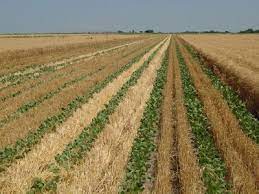Relay cropping is an agricultural practice that involves planting a second crop before the first crop is harvested, thereby making use of the residual soil moisture and nutrients to grow the second crop. This practice has gained popularity in recent years due to its potential to increase crop yields and improve soil health, while also providing environmental benefits such as reduced soil erosion and increased carbon sequestration.

Relay cropping is particularly effective in regions with a limited growing season, as it allows farmers to maximize the use of their land and resources by growing multiple crops in a single season.
For example, in areas with a short growing season, farmers may plant a winter crop such as wheat or barley in the fall, followed by a summer crop such as soybean or corn after the winter crop is harvested. By doing so, they can make use of the residual moisture and nutrients in the soil, and increase the overall productivity of their land.
One of the key benefits of relay cropping is the increased carbon sequestration in the soil. As plants grow, they absorb carbon dioxide from the atmosphere and convert it into organic matter, which is then stored in the soil. Relay cropping promotes the growth of multiple crops in a single season, which leads to increased plant biomass and greater carbon sequestration in the soil. This not only helps to mitigate climate change by reducing the amount of carbon dioxide in the atmosphere but also improves soil health and fertility, leading to better crop yields in the long term.
Another benefit of relay cropping is the reduction of soil erosion. By keeping the soil covered with vegetation throughout the growing season, relay cropping helps to protect the soil from wind and water erosion, which can lead to the loss of valuable topsoil and nutrients. This not only improves the productivity of the land but also helps to maintain the long-term health of the soil and surrounding ecosystem.
In addition to its environmental benefits, relay cropping can also be economically beneficial for farmers. By increasing crop yields and improving soil health, relay cropping can lead to higher profits and more sustainable agricultural practices. Moreover, by planting multiple crops in a single season, farmers can diversify their crop portfolio and reduce their exposure to weather and market fluctuations.
In conclusion, relay cropping is a sustainable agricultural practice that can lead to increased crop yields, improved soil health, and reduced environmental impact. By making use of residual soil moisture and nutrients, farmers can plant multiple crops in a single season, leading to greater carbon sequestration, reduced soil erosion, and more sustainable agricultural practices. With the increasing need for sustainable agriculture practices, relay cropping is emerging as a promising solution to help farmers increase their productivity while also preserving the environment.
Important Links